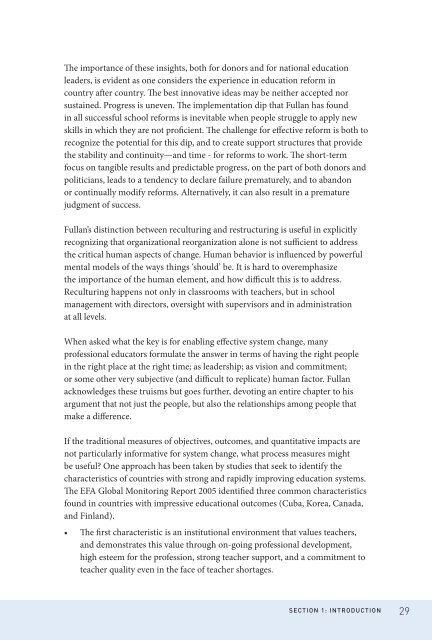The Power of Persistence: Education System ... - EQUIP123.net
The Power of Persistence: Education System ... - EQUIP123.net
The Power of Persistence: Education System ... - EQUIP123.net
You also want an ePaper? Increase the reach of your titles
YUMPU automatically turns print PDFs into web optimized ePapers that Google loves.
<strong>The</strong> importance <strong>of</strong> these insights, both for donors and for national education<br />
leaders, is evident as one considers the experience in education reform in<br />
country after country. <strong>The</strong> best innovative ideas may be neither accepted nor<br />
sustained. Progress is uneven. <strong>The</strong> implementation dip that Fullan has found<br />
in all successful school reforms is inevitable when people struggle to apply new<br />
skills in which they are not pr<strong>of</strong>icient. <strong>The</strong> challenge for effective reform is both to<br />
recognize the potential for this dip, and to create support structures that provide<br />
the stability and continuity—and time - for reforms to work. <strong>The</strong> short-term<br />
focus on tangible results and predictable progress, on the part <strong>of</strong> both donors and<br />
politicians, leads to a tendency to declare failure prematurely, and to abandon<br />
or continually modify reforms. Alternatively, it can also result in a premature<br />
judgment <strong>of</strong> success.<br />
Fullan’s distinction between reculturing and restructuring is useful in explicitly<br />
recognizing that organizational reorganization alone is not sufficient to address<br />
the critical human aspects <strong>of</strong> change. Human behavior is influenced by powerful<br />
mental models <strong>of</strong> the ways things ‘should’ be. It is hard to overemphasize<br />
the importance <strong>of</strong> the human element, and how difficult this is to address.<br />
Reculturing happens not only in classrooms with teachers, but in school<br />
management with directors, oversight with supervisors and in administration<br />
at all levels.<br />
When asked what the key is for enabling effective system change, many<br />
pr<strong>of</strong>essional educators formulate the answer in terms <strong>of</strong> having the right people<br />
in the right place at the right time; as leadership; as vision and commitment;<br />
or some other very subjective (and difficult to replicate) human factor. Fullan<br />
acknowledges these truisms but goes further, devoting an entire chapter to his<br />
argument that not just the people, but also the relationships among people that<br />
make a difference.<br />
If the traditional measures <strong>of</strong> objectives, outcomes, and quantitative impacts are<br />
not particularly informative for system change, what process measures might<br />
be useful One approach has been taken by studies that seek to identify the<br />
characteristics <strong>of</strong> countries with strong and rapidly improving education systems.<br />
<strong>The</strong> EFA Global Monitoring Report 2005 identified three common characteristics<br />
found in countries with impressive educational outcomes (Cuba, Korea, Canada,<br />
and Finland).<br />
• <strong>The</strong> first characteristic is an institutional environment that values teachers,<br />
and demonstrates this value through on-going pr<strong>of</strong>essional development,<br />
high esteem for the pr<strong>of</strong>ession, strong teacher support, and a commitment to<br />
teacher quality even in the face <strong>of</strong> teacher shortages.<br />
SECTION 1: INTROdUCTION<br />
29

















